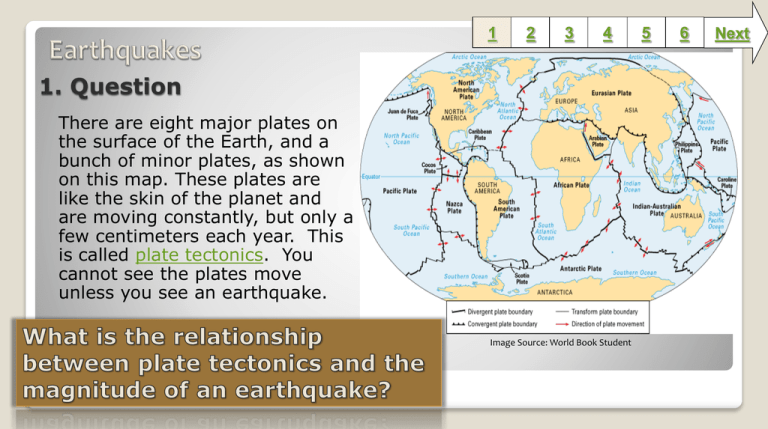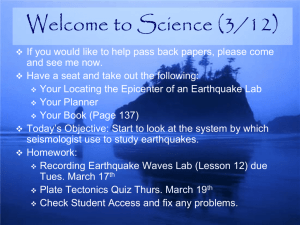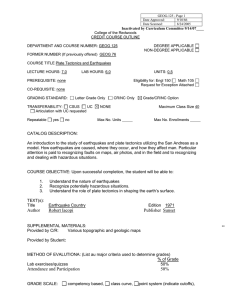
1
2
3
4
1. Question
There are eight major plates on
the surface of the Earth, and a
bunch of minor plates, as shown
on this map. These plates are
like the skin of the planet and
are moving constantly, but only a
few centimeters each year. This
is called plate tectonics. You
cannot see the plates move
unless you see an earthquake.
Image Source: World Book Student
5
6
Next
2. Information Sources
1
2
3
4
5
As you use the information sources below,
organize your new knowledge of
earthquakes in order to complete the
Student Activity on Slide 3.
Read the information and view the
graphics to understand more about
earthquakes.
Watch the BrainPop to learn more about
earthquakes.
Watch the Bill Nye video on what makes
earthquakes happen and the instruments
used to measure them.(Need a Safari Login)
Read about moment magnitude to learn
more about earthquakes are measured.
Image Source: World Book Student
Image Source: Clipart.com
6
Next
3. Student Activity
With a partner, make your own
earthquakes. Change the
length, depth and slip of the
earthquake and guess what you
think the magnitude will be.
Then, find out the actual
magnitude of the earthquake you
created, and see what the effects
of an earthquake with that
magnitude would look like.
Record information about your
earthquake simulations so that
you can draw conclusions about
how the change in measurements
affects the magnitude of an
earthquake.
1
2
Image Source: World Book Student
3
4
5
6
Next
4. Assessment Activity
1
2
3
4
5
The 2004 movie 10.5 depicts what might
happen to the western United States if
it was ever destroyed by earthquakes.
After two earthquakes hit, scientists
believe an earthquake registering 10.5
on the Richter scale could be next.
Is an earthquake with a magnitude
of 10.5 possible? Why or why not?
Support your response with details
from your research on plate
tectonics, earthquakes, and how
they are measured.
Organize your thoughts for your response.
Present your response as directed by your
teacher. Your teacher may have you choose
a Web 2.0 tool like a VoiceThread or a Voki
to present your response.
The PBS link above will help you understand the after
effects of an earthquake.
6
Next
5. Enrichment Activities
1
2
3
4
5
Separating Fact from Fiction:
Read up on the scientific
inaccuracies from the movie
10.5.
Today in Earthquake History:
Learn about real earthquakes
that have occurred on specific
dates.
Ask a Geologist: Email or text
questions about earthquakes to
a geologist.
Image Source: Southern California Earthquake Center (SCEC)
6
Next
6. Teacher Support Materials
1
2
3
Time Frame: Two fifty-minute class periods
Differentiation:
Direct students to use comprehension tools included in
databases, such as: audio read-aloud, labeled reading levels,
and embedded dictionaries.
Organizers may be modified to meet the needs of students.
Activity Assessment: Students may choose to hand write their
response to the question.
Learning Styles: Visual, Auditory, Active, Reflective, Global
Understanding, Analytical Understanding
Maryland State Curriculum
Objectives a and b
Notes to the teacher: Review the informational sources before
students begin in order to be prepared for any questions they may
have regarding information they acquire from them. You may need
to assist students in logging on to Safari Montage. Students may
need to login to BrainPop for some of the videos.
Recognize and describe the evidence for plate movement.
4
5
6
Standard 2.0 Earth/Space Science
Students will use scientific skills and processes to explain the chemical and physical interactions
(i.e., natural forces and cycles, transfer of energy) of the environment, Earth, and the universe
that occur over time.
Topic C. Plate Tectonics
Indicator 2. Recognize and explain how major geologic events are a result of the movement of
Earth's crustal plates.
BCPS Goal 2: Earth Space Science
◦
Shape of continents
◦
Continuity of geologic features and fossils on the continents
◦
Ocean rifts, seafloor spreading
◦
Global patterns of earthquakes and volcanoes
Recognize and explain that major geologic events (earthquakes, volcanic activity, sea floor
spreading) occur along crustal plate boundaries.
The student will demonstrate the ability to use scientific skills and
processes (Core Learning Goal 1) to explain the physical
behavior of the environment, Earth, and the universe.
Geosphere (2.4)
Reading: 1. Read closely to determine what the text says explicitly and to make logical
inferences from it; cite specific textual evidence when writing or speaking to support conclusions
drawn from the text.
Expectation 4: The student will analyze the dynamic nature of the
lithosphere in order to investigate methods that geologists use to
determine the history of Earth.
Indicators 2.4.3, 2.4.4, 2.4.5
3. The student will explain changes in Earth’s surface using plate
tectonics.
4. The student will apply geologic principles to analyze the geologic
and biologic events in Earth’s history.
Common Core State Standards
Writing: 7. Conduct short as well as more sustained research projects based on focused
questions, demonstrating understanding of the subject under investigation.
Standards for the 21st Century Learner
1.1.6 Read, view, and listen for information presented in any format (e.g. textual, visual,
media, digital) in order to make inferences and gather meaning.
2.1.3 Use strategies to draw conclusions from information and apply knowledge to curricular
areas, real-world situations, and further investigations.
5. The student will describe the purpose and advantage of current
Maryland Technology Literacy Standards for Students
tools, delivery systems and techniques used to study the
3.0: Use a variety of technologies for learning and collaboration.
lithosphere.
Updated: July 2015 Created by Laura Herzog , Classroom Teacher/Library Media Intern
BCPS Slam Dunk Research Model, Copyright 2013, Baltimore County Public Schools, MD, all rights reserved. The models may be used for educational, non-profit school use only.
All other uses, transmissions, and duplications are prohibited unless permission is granted expressly. This lesson is based on Jamie McKenzie’s Slam Dunk Lesson module.






